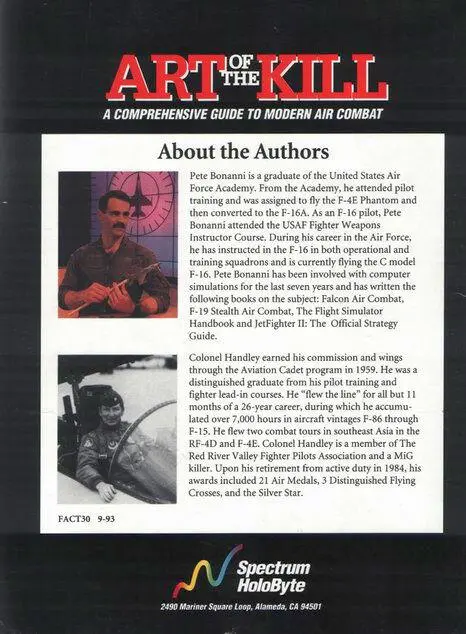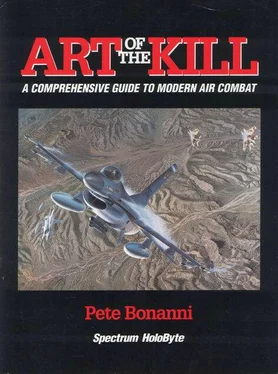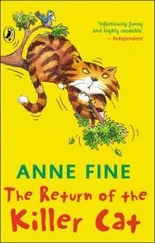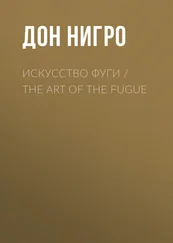Pete Bonanni - The Art of the Kill
Здесь есть возможность читать онлайн «Pete Bonanni - The Art of the Kill» весь текст электронной книги совершенно бесплатно (целиком полную версию без сокращений). В некоторых случаях можно слушать аудио, скачать через торрент в формате fb2 и присутствует краткое содержание. Город: Alameda, CA, Год выпуска: 1993, Издательство: Spectrum HoloByte, Жанр: Прочая справочная литература, на английском языке. Описание произведения, (предисловие) а так же отзывы посетителей доступны на портале библиотеки ЛибКат.
- Название:The Art of the Kill
- Автор:
- Издательство:Spectrum HoloByte
- Жанр:
- Год:1993
- Город:Alameda, CA
- ISBN:нет данных
- Рейтинг книги:4 / 5. Голосов: 1
-
Избранное:Добавить в избранное
- Отзывы:
-
Ваша оценка:
- 80
- 1
- 2
- 3
- 4
- 5
The Art of the Kill: краткое содержание, описание и аннотация
Предлагаем к чтению аннотацию, описание, краткое содержание или предисловие (зависит от того, что написал сам автор книги «The Art of the Kill»). Если вы не нашли необходимую информацию о книге — напишите в комментариях, мы постараемся отыскать её.
Video lessons: http://youtu.be/OCFMX5z-ed4
[C
tables. Best viewed with CoolReader.]
The Art of the Kill — читать онлайн бесплатно полную книгу (весь текст) целиком
Ниже представлен текст книги, разбитый по страницам. Система сохранения места последней прочитанной страницы, позволяет с удобством читать онлайн бесплатно книгу «The Art of the Kill», без необходимости каждый раз заново искать на чём Вы остановились. Поставьте закладку, и сможете в любой момент перейти на страницу, на которой закончили чтение.
Интервал:
Закладка:
Pete Bonanni
THE ART OF THE KILL
A Comprehensive Guide to modern Air Combat

Foreword
Art of the Kill has been designed to teach you the fundamentals of Basic Fighter Maneuvers (BFM). As the name implies, BFM is the cornerstone of tactical fighter aviation. Since its principles are rooted in the laws of physics, geometry and aerodynamics, they are non-negotiable and cannot be finessed.
Depending upon what your expectations were when you purchased Art of the Kill, a couple of learning outcomes are possible. If you watch the videotape only once as you flip through this book, you will probably be mildly entertained and may even retain a few basic principles of BFM. If on the other hand, you read this book in conjunction with repeated reviews of Pete Bonanni’s excellent videotaped presentations, you’ll learn and understand the imperatives of how to maneuver aircraft in a visual engagement environment. I can guarantee you that such knowledge will serve you well.
There is a growing myth that the technological sophistication of the modern fighter aircraft has turned aerial combat into a “push button” form of high-tech warfare. So you may be wondering why, in an era of pulse-doppler radar, low observable technology and sophisticated missiles, should one devote time and energy to learning something as old-fashioned as BFM. Why not simply “shoot ’em in the face” before they ever see you? More than a few sincere advocates have been making that argument for years. As an aspiring fighter pilot in the 1950s, I first heard the same siren song when the F-86 was armed with the original AIM-9 Sidewinder missile. The story line then was that missiles of that ilk, used in combination with radar control, were going to make “dogfighting” a thing of the past with the fighter pilot being relegated to a role of pushing “magic buttons” upon command. It didn’t happen then; it didn’t happen with the introduction of the “Century Series” supersonic fighters; it didn’t happen with the development of F-15s, F-16s, F/A-18s or any of the other first-line fighters of today; and if I were a betting man, I’d wager that it won’t happen anytime soon.
It continues to be my personal belief that some of the detractors of BFM do so simply because of their own ineptitude. Other commanders of the past, who were more interested in personal career advancement than the combat skills of their pilots, disdained BFM because of their fear of losing an aircraft (and their careers). Others really do believe that they will always “blow through” the merge, never get tangled up, and always let the “magic of technology” do the work. In my opinion, their theory is as flawed as that of a boxer who declares that he will “never hook with a hooker.” If you hang around the boxing game long enough, sooner or later you are going to find yourself in that squared ring with the likes of a Joe Frazier. By the same token, if you fly air-to-air combat long enough, one day you will find yourself looking across a turning circle at a guy whose main objective is to see to it that you die for your country. At this point, extending out of the fight is simply not a viable option (unless, of course, you feel that his missile won’t run you down). It’s like riding a hog… there is no way to get off. It’s also a terrible time to learn BFM.
Make no mistake about it, though: I do not advocate BFM as a panacea, but instead as an absolutely essential skill within the professional fighter pilot’s stock and trade. Any thoughtful examination of today’s aerial combat arena will show that longevity does not accrue to those who make it their habit to enter into sustained turning engagements at the merge. Such action draws enemy fighters like a magnet and makes you highly vulnerable to the unobserved “meat shot.” However, great BFM skills will allow you to quickly bring your guns or short-range missiles to bear for the quick kill, while avoiding the pitfalls of the sustained turning fight. They can also ensure that should you find yourself trapped in a 1V1 from which you cannot disengage, that you afford your adversary the opportunity to die for hiscountry.
During the course of World War II, the great German ace, Eric Hartmann, shot down at least 352 enemy fighters while using the single employment tactic of see, decide, attack and break. Could “Bubi” Hartmann fly great BFM? You bet he could, but unfortunately those most qualified to attest to that fact are no longer here. Yet, he was not single-minded or foolish about the application of his considerable skills. In his book, The Blonde Knight of Germany, he details the folly of sole reliance upon sheer “stick and rudder” talent and refers to those so inclined as “Muscle Flyers” (of which, incidentally, there are few, if any, who remain). So if you’re looking for a set of baseline employment tactics to adopt, I would suggest that you shamelessly copy that of the “Ace of Aces,” for they are as valid in today’s best fighters as they were almost a half century ago in the Bf-109. The bottom line is that BFM is to air combat as blocking and tackling are to football. Is it worth your time and effort to master it? I’ll close with the following observation:
Statistics of aerial combat have consistently shown that approximately 10% of the fighter pilots achieve over 80% of the air-to-air kills. Of the thousands of fighter pilots with whom I have been associated over the years, it has been my good fortune to fly and serve with many of that top 10%. I have never met a single one of them who was not an outstanding BFM pilot. As is said in the accompanying videotape: “In the fighter game, if you can’t fly great Basic Fighter Maneuvers, you’ll never amount to a hill of beans.”
Good hunting and 6, Phil “Hands” Handley
6, Phil “Hands” Handley
Preface
Simply put, the Art of the Kill series is a comprehensive audiovisual guide to modern air-to-air combat.
Anyone who enjoys reading “techno-thrillers” describing air combat engagements, who likes watching the popular “Wings” television show, who is interested in the topics of military aviation, air combat or modern flight simulations, and who has wondered how modern jet fighter pilots actually do what they do will enjoy this product. Art of the Kill demonstrates the “hows and whys” of modern air combat and is the only product of its kind to present its message in a multimedia format.
The Art of the Kill book was written by Pete Bonnani, an Air National Guard officer whose primary job is to train fighter pilots in air-to-air combat. Each chapter in this book begins by describing a situation this Weapons Officer and Instructor Pilot experienced while delivering on-the-ground and in-the-air training to his F-16 pilots. These stories illustrate the complex task of learning modern air combat skills and some of the unusual situations he and his students have experienced in the process.
Most existing books about air-to-air combat are either historical retrospectives, biographies or highly technical texts written primarily as syllabuses for Fighter Weapons training. This is the first study written expressly with the layperson in mind: someone who may find air combat fascinating and may relish the opportunity to understand how it is learned and done, but who has awaited until now an entertaining and understandable treatment of the subject matter.
Immediately following each story in Art of the Kill is a series of explanations and diagrams directly relating to the air-to-air combat situation presented in the story and illustrating step-by-step how modern air combat is learned and successfully executed. In addition, for a real “Fighter Weapons School” experience, the lesson plans at the end of the book contain written DLOs [1] DLOs — Desired Learning Objectives
for each chapter (a training methodology used in actual Fighter Weapons schools), as well as a brief “quiz” on the material with answer keys.
Интервал:
Закладка:
Похожие книги на «The Art of the Kill»
Представляем Вашему вниманию похожие книги на «The Art of the Kill» списком для выбора. Мы отобрали схожую по названию и смыслу литературу в надежде предоставить читателям больше вариантов отыскать новые, интересные, ещё непрочитанные произведения.
Обсуждение, отзывы о книге «The Art of the Kill» и просто собственные мнения читателей. Оставьте ваши комментарии, напишите, что Вы думаете о произведении, его смысле или главных героях. Укажите что конкретно понравилось, а что нет, и почему Вы так считаете.












